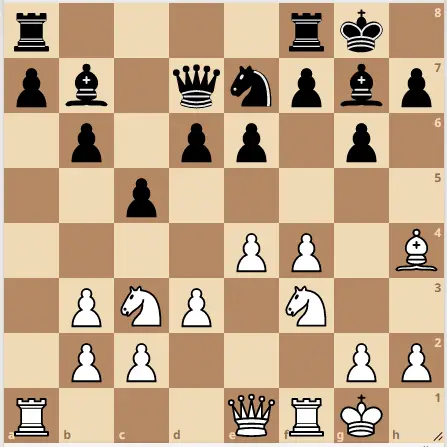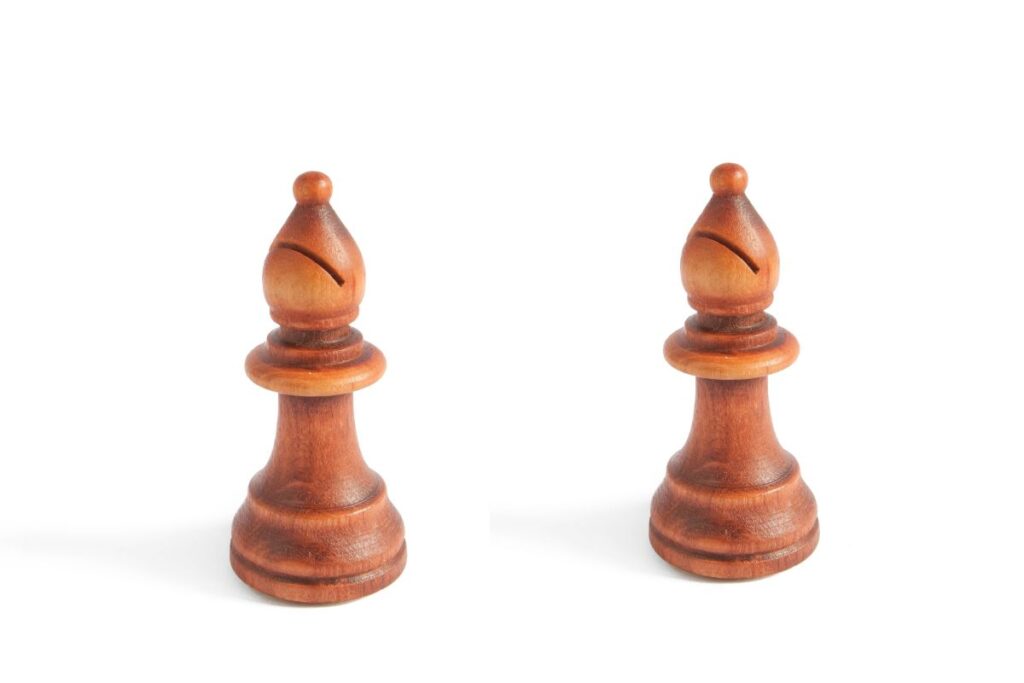One of the most valuable combinations in chess is the bishop pair, which refers to having both your light-squared bishop and dark-squared bishop on the board at the same time.
The bishop pair can give a player greater control of the board and potential threats to the opponent’s position.
Understanding the significance of the bishop pair and how to use it effectively can give players a significant advantage in the game.
In this article, we will explore the concept of the bishop pair in chess, its strengths and weaknesses, and how to use it to achieve success in the game.
What Is A Bishop Pair?
In chess, the bishop pair refers to a situation where a player has both of their bishops on the board, while their opponent has lost at least one of their bishops.
Black has the bishop pair

Having the bishop pair is generally considered advantageous because the bishops can work together to control more squares on the board than a single bishop could.
Additionally, the two bishops can work together to create threats and apply pressure to the opponent’s position.
It is often said that the value of the bishop pair increases as the game progresses and the number of pieces on the board decreases, as the bishops become even more powerful in more open positions.
How To Use Your Bishop Pair In Chess?
Using your bishop pair effectively in chess depends on the position, as the optimal use of the bishops can vary depending on the specific circumstances. However, here are some general tips for using your bishop pair:
Bishops are powerful when they can control long, open diagonals, as they can attack the opponent’s position from afar and create threats. Look for opportunities to clear the center pawns to open up diagonals for your bishops.
Coordinate your bishops
Coordinate your bishops to control important squares and work together to create threats. If one bishop controls light squares, the other can control dark squares, allowing them to cover more ground.
Consider pawn structure
Be aware of your pawn structure and how it affects your bishops. If your pawns are fixed on the same color as your bishops, your bishops may be limited in their mobility. Try to keep your pawns on the opposite color to your bishops.
Use bishops in endgames
Bishops are particularly strong in endgames, where they can control both sides of the board and potentially dominate the opponent’s pieces. Look for opportunities to trade other pieces to reach a bishop endgame.
Be cautious of knights
Be aware of the opponent’s knights, as knights can be tricky to deal with for bishops. Knights can attack and potentially control squares that are out of reach for bishops, so be careful not to leave your bishops vulnerable to knight forks.
Overall, the key to using your bishop pair effectively is to control open diagonals, coordinate your bishops, be aware of pawn structure, use bishops in endgames, and be cautious of knights.
By following these general principles and adjusting to the specific position, you can make the most of your bishop pair and create threats against the opponent’s position.
How To Get The Bishop Pair?
To get the bishop pair, you need to have both your light-squared bishop and your dark-squared bishop on the board while your opponent has either one bishop or none. Here are a few ways to achieve this:
Develop both bishops early
One way to try to get the bishop pair is to develop both bishops early in the game, ideally before the knights or other pieces block their paths.
This can give you more control of the board and potentially force your opponent to exchange their bishop(s) for your other pieces.
Exchange pieces strategically
Look for opportunities to exchange your pieces for your opponent’s pieces in a way that allows you to keep your bishop pair.
For example, if your opponent has a bishop on a square that can be attacked by your knight, consider exchanging the knight for the bishop to leave your bishop pair intact.
Take advantage of your opponent’s mistakes
Sometimes, your opponent may make a mistake that allows you to capture one of their bishops, leaving them with only one bishop or none.
For example, if your opponent leaves their bishop unprotected or puts it on a square where it can be attacked, you may be able to take it with your own bishop or other piece.
Remember that getting the bishop pair is not always a goal in itself, but rather a means to achieve other strategic objectives.
Depending on the position, having the bishop pair may be advantageous or not, so it’s important to consider the specific circumstances and adjust your plans accordingly.
Why is a bishop pair better than a knight pair?
The bishop pair is generally considered stronger than a knight pair for a few reasons:
Greater control of squares
The bishops, as long-range pieces, can control more squares on the board than knights. Having two bishops allows a player to control squares of both colors, whereas two knights can only control squares of the same color.
Complementary nature
The two bishops complement each other well and can cover each other’s weaknesses. For example, one bishop may control light squares while the other controls dark squares. In contrast, two knights can get in each other’s way and compete for squares.
More potential mobility
Bishops have the potential to move across the board more quickly and easily than knights, especially in open positions. This can make it easier for a player with the bishop pair to create threats and attack the opponent’s position.
Stronger in open positions
In more open positions with fewer pawns and pieces on the board, the bishop pair becomes even more powerful, as the bishops have more scope and can control more squares. In contrast, knights can struggle in open positions where they have fewer outposts to occupy.
Overall, while knights have their own strengths and can be very powerful in certain positions, the bishop pair is generally considered stronger because of the greater control of squares, complementary nature, potential mobility, and strength in open positions.
Disadvantage of Bishop Pair
While having the bishop pair can be a valuable asset in chess, there are also some potential disadvantages to consider:
Limited mobility in closed positions:
In closed positions where pawns block the board, bishops may have limited mobility and be unable to control key squares. In such situations, knights may be more effective as they can jump over pawns to control squares that are out of reach for bishops.
Vulnerability to knight attacks
Knights can be a tricky piece to deal with for bishops, as they can attack and potentially control squares that are out of reach for bishops. If the opponent has well-placed knights, they may be able to limit the mobility of your bishops and make it difficult to use them effectively.
Weaknesses in pawn structure
The bishop pair can be weakened if your pawns are fixed on the same color as your bishops, limiting their mobility and potential for control. Additionally, if your opponent has strong pawns on the opposite color of your bishops, it may be difficult to use them effectively.
Coordination challenges
While having two bishops can be advantageous in controlling more squares, it also requires coordination to use them effectively. If the bishops are not well-coordinated, they may not be able to create effective threats or control key squares.
Overall, while the bishop pair is generally considered a valuable asset, it is important to consider the specific position and potential weaknesses before relying too heavily on the bishops. A skilled opponent may be able to exploit the weaknesses of the bishop pair, so it’s important to have a flexible and adaptable strategy in chess.
Is a bishop pair stronger than a pair of rooks?
Comparing a bishop pair to a pair of rooks is not straightforward, as both have their own unique strengths and weaknesses.
In general, a pair of rooks is considered a more powerful combination than a bishop pair because of the rooks’ ability to control open files, coordinate to create threats, and dominate the board.
A pair of rooks working together can control open files and penetrate the opponent’s position through their defenses, creating multiple threats simultaneously.
They can also coordinate to control important squares and dominate the board, particularly in open or semi-open positions where their range is not blocked by pawns or pieces.
In contrast, while a bishop pair is very strong in controlling diagonals and can potentially control more squares than a single rook, bishops generally require open diagonals to be truly effective.
If the position is closed, the bishop’s range may be limited, and it can be difficult to use them to create concrete threats against the opponent’s position.
Overall, while the bishop pair is a powerful combination, a pair of rooks is generally considered stronger due to their ability to coordinate and control open files, penetrate the opponent’s position, and dominate the board.
Final Thoughts
The bishop pair refers to having both your light-squared bishop and dark-squared bishop on the board at the same time.
This combination of bishops is considered a valuable asset in chess, as it allows for greater control of the board and potential threats to the opponent’s position.
Understanding how to use the bishop pair effectively can be a key factor in achieving success in the game, but it is important to remember that it is just one of many strategic elements to consider in chess.


